|
|
|
|
Late Entries to a Survey of Bestiaries
The staff of the Poison Pie Publishing House assembled a survey of one hundred bestiaries, posting an entry on their blog for each day from June 1, 2016 to September 8, 2016. When they were done, there were additional bestiaries that they did not want to omit entirely. This page lists latecomers to the survey.
|
|
|
|
|
September 09, 2016
Monsters from the Id: The H.R. Giger Bestiary
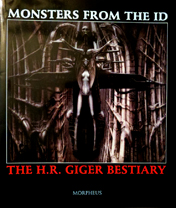 designer: -
designer: -
interior artist: H.R. Giger
cover artist: H.R. Giger
publisher: Galerie Morpheus International Inc.
publication date: 1998
cover: softcover
number of pages: 44
ISBN: none
description: This bestiary presents color plates by H.R. Giger.
Our featured entry from this bestiary is the female magician. This bestiary contains no text descriptions accompanying the illustrations.
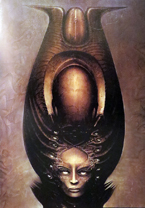 FEMALE MAGICIAN
FEMALE MAGICIAN
1973 Acrylic on Paper 24" x 52" (detail)
|
|
|
|
|
September 10, 2016
Fantastic Beasts and Where to Find Them
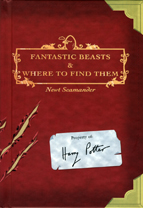 in-world author: Newt Scamander
in-world author: Newt Scamander
author: J.K. Rowling
cover artist: uncredited
in-world publisher: Obscurus Books of 18a Diagon Alley, London
publisher: Arthur A. Levine Books
publication date: 2001
cover: hardcover
number of pages: 42
ISBN: 0-439-32160-3
description: This bestiary is written as a textbook for use at Hogwarts School of Witchcraft and Wizardry. Most of the entries do not include illustrations. The illustration featured here is taken from the slipcase for an edition of the book packaged with Quidditch Through the Ages by Kennilworthy Whisp.
Our featured entry from this bestiary is the troll.
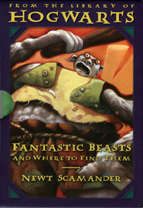 The troll is a fearsome creature up to twelve feet tall and weighing over a tonne. Notable for its equally prodigious strength and stupidity, the troll is often violent and unpredictable. Trolls originated in Scandinavia but these days they may be found in Britain, Ireland and other areas of northern Europe.
The troll is a fearsome creature up to twelve feet tall and weighing over a tonne. Notable for its equally prodigious strength and stupidity, the troll is often violent and unpredictable. Trolls originated in Scandinavia but these days they may be found in Britain, Ireland and other areas of northern Europe.
Trolls generally converse in grunts that appear to constitute a crude language, though some have been known to understand and even to speak a few simple human words. The more intelligent of the species have been trained as guardians.
There are three types of troll: mountain, forest and river. The mountain troll is the largest and most vicious. It is bald, with a pale-grey skin. The forest troll has a pale-green skin and some specimens have hair, which is green or brown, thin, and straggly. The river troll has short horns and may be hairy. It has a purplish skin, and is often found lurking beneath bridges. Trolls eat raw flesh and are not fussy in their prey, which ranges from wild animals to humans.
|
|
|
|
|
September 11, 2016
Legions of Hell. Book of Fiends. Volume One
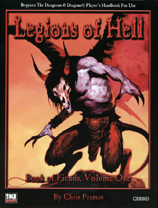 author: Chris Pramas
author: Chris Pramas
interior artists: Sam Wood et al.
cover artist: Brom
publisher: Green Ronin Books
publication date: 2001
cover: softcover
number of pages: 64
ISBN: 0-9701048-4-7
description: This bestiary focuses on devils. It is compatible with the d20 system.
Our featured entry from this bestiary is the distender.
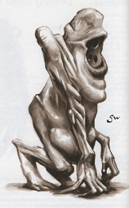 Distenders are truly foul devils that can be found in all the circles of Hell. Students of the infernal argue over whether distenders were born or bred. Their existence is commonly attributed to Mephistopheles, but it seems unlike the old fox to put such a potent weapon into the hands of his enemies.
Distenders are truly foul devils that can be found in all the circles of Hell. Students of the infernal argue over whether distenders were born or bred. Their existence is commonly attributed to Mephistopheles, but it seems unlike the old fox to put such a potent weapon into the hands of his enemies.
A distender looks like a giant bloated stomach with arms and legs. Its body is divided into four inner chambers, each of which produces one of the four classic humors: black bile, blood, phlegm and yellow bile. It can regurgitate huge quantities of these fluids, operating as a sort of living artillery piece for artillery piece for infernal armies. The humors' effects are especially potent on the Prime, and even one distender can carry a battle for the forces of evil. Infernal agents and minions thus frequently summon them.
|
|
|
|
|
September 12, 2016
Armies of the Abyss. Book of Fiends. Volume Two
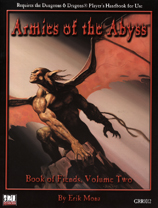 author: Erik Mona
author: Erik Mona
interior artist: Tom Baxa et al.
cover artist: Brom
publisher: Green Ronin Books
publication date: 2002
cover: softcover
number of pages: 64
ISBN: 0-9714380-0-5
description: This bestiary focuses on demons. It is compatible with the d20 system.
Our featured entry from this bestiary is Rahu the Tormentor (Tanar'ri Lord).
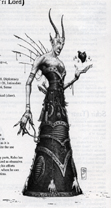 Torturers everywhere pray to the demon prince Azidahaka as a patron of both truth and lies. They're much more likely to respect his chief "surgeon", Rahu the Tormentor, though, as it is Rahu who frequently visits the Material Plane to evangelize the use of torture as a means of political control.
Torturers everywhere pray to the demon prince Azidahaka as a patron of both truth and lies. They're much more likely to respect his chief "surgeon", Rahu the Tormentor, though, as it is Rahu who frequently visits the Material Plane to evangelize the use of torture as a means of political control.
A collector of both surgical instruments and preserved body parts, Rahu has an interest in human physiology and anatomy best categorized as obsessive. He tires of working under the paranoid Azidahaka, wasting his efforts upon demons and souls. He longs to flee to a mortal world, where he can continue his grim work with no shortage of live human victims.
Impossibly gaunt, Rahu nonetheless possesses an oddly handsome visage, with fine features and delicate blue skin. Two long, elegant horns emerge from his forehead, stretching more than a foot in length. The Tormentor speaks in a soothing low voice that would put listeners at ease if it came from the mouth of anyone else. He favors highly fetishized garments of tight leather, accenting the assembly with a blood-splattered apron. Dozen of small saws, awls, vises, and worse dangle from the apron, some still thick with the skin and fluids of past unfortunates.
|
|
|
|
|
September 13, 2016
Monsternomicon. Volume 1. Denizens of the Iron Kingdoms
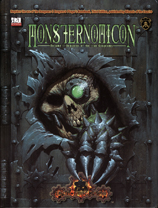 authors: Doug Seacat et al.
authors: Doug Seacat et al.
interior artists: -
cover artist: uncredited
publisher: Privateer Press
publication date: 2002
cover: hardcover
number of pages: 240
ISBN: 0-9706970-3-1
description: This bestiary is for use with the Iron Kingdoms setting. It is compatible with the d20 system.
Our featured entry from this bestiary is the tomb maiden.
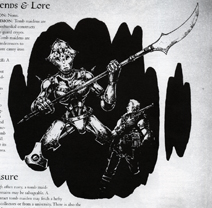 In appearance, the tomb maiden resembles an armored human woman, except that woman is roughly 9 feet tall and constructed of iron. Tomb maidens theoretically are a precursor to the more cunning iron maidens, and they are only found in the most ancient and undisturbed crypts. They fight to protect the contents of said crypts, guarding it with absolute vigilance, often wielding enormous halberds but occasionally employing other large weaponry.
In appearance, the tomb maiden resembles an armored human woman, except that woman is roughly 9 feet tall and constructed of iron. Tomb maidens theoretically are a precursor to the more cunning iron maidens, and they are only found in the most ancient and undisturbed crypts. They fight to protect the contents of said crypts, guarding it with absolute vigilance, often wielding enormous halberds but occasionally employing other large weaponry.
Some time ago, I had the displeasure of encountering one of these constructs in a long-forgotten Cygnaran sepulcher. My assistant and I had just penetrated what we thought was the last chamber in a series of dust-choked burial vaults. As I carefully cleared away the dust and cobwebs from what appeared to be the epitaph of Lady Methilde of Llorvast, a great crack appeared in the wall in which the tribute to the lady had been inscribed. All at once, the wall exploded in a thundering surge of debris, a huge halberd suddenly protruding from the dust and darkness. One swing of that massive polearm and my poor assistant Jek was impaled....I took the opportunity to make good my escape...There was quite a bit of running that followed, and eventually I once more saw the light of day. Evidently the tomb maiden's pursuit had ended, since it never followed me out of the crypt.
|
|
|
|
|
September 14, 2016
Malleus Monstrorum. Creatures, Gods & Forbidden Knowledge. Expanded English Edition in 380 Entries.
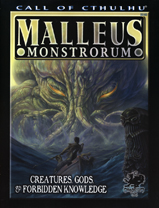 authors: Scott David Aniolowski with Sandy Petersen & Lynn Willis
authors: Scott David Aniolowski with Sandy Petersen & Lynn Willis
interior artists: Pascal D. Bohr et al.
cover artist: Lee Gibbons
publisher: Chaosium Inc.
publication date: 2006
cover: softcover
number of pages: 296
ISBN: 978-1568821795
description: This bestiary is for use with the Call of Cthulhu game. It is compatible with the BRP (Basic Roleplaying Game) system.
Our featured entry from this bestiary are the deep ones, a lesser servitor race.
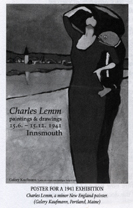 I think their predominant color was a greyish-green, thought they had white bellies. They were mostly shiny and slippery, but the ridges of their backs were scaly. Their forms suggested the anthropoid, while their heads were the heads of fish, with prodigious bulging eyes that never closed. At the sides of their necks were palpitating gills and their long paws were webbed. They hopped irregularly, sometimes on hind legs and sometimes on four...their croaking, baying voices...held all the dark shades of expression with their staring faces lacked.
I think their predominant color was a greyish-green, thought they had white bellies. They were mostly shiny and slippery, but the ridges of their backs were scaly. Their forms suggested the anthropoid, while their heads were the heads of fish, with prodigious bulging eyes that never closed. At the sides of their necks were palpitating gills and their long paws were webbed. They hopped irregularly, sometimes on hind legs and sometimes on four...their croaking, baying voices...held all the dark shades of expression with their staring faces lacked.
- H.P. Lovecraft, "The Shadow over Innsmouth"
The deep ones are an amphibious race that serves primarily Cthulhu and two beings known as Father Dagon and Mother Hydra. Locked in a the timeless depths of the sea, their alien, arrogant lives are coldly beautiful, unbelievably cruel, effectively immortal. They come together to mate or to worship Cthulhu, but do not crave touching or being touched as humans do. They are a marine race, unknown in freshwater environments, and globally have many cities, all submerged beneath the waves. The three major cities of the deep ones are: Y'hanth-lei off the coast of Massachusetts, near Innsmouth; Ahi-Y'hloa off the coast of Great Britain near Cornwall, and G'll-Hoo in the North Sea.
|
|
|
|
|
September 15, 2016
Star Wars: The Essential Guide to Droids
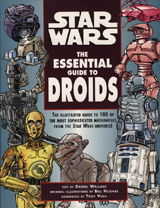 author: Daniel Wallace
author: Daniel Wallace
interior artist: Bill Hughes
cover artist: Bill Hughes
publisher: Del Rey Books
publication date: March, 1999
cover: softcover
number of pages: 206
ISBN: 0-345-42067-5
description: This bestiary focuses on droids of the Star Wars universe.
Our featured entry from this bestiary is the MSE-6 ("Mouse Droid").
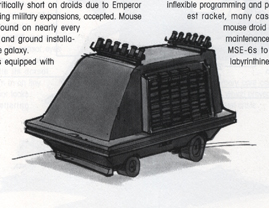 Tiny, ubiquitous, and annoying, MSE-6 droids scurry through the corridors of Star Destroyers like scrounging rodents on the primitive sailing barges of yore. Even though most officers hate the sight of them, "mouse droids" are simple, reliable, and cheap, and are unlikely to disappear from the military any time soon.
Tiny, ubiquitous, and annoying, MSE-6 droids scurry through the corridors of Star Destroyers like scrounging rodents on the primitive sailing barges of yore. Even though most officers hate the sight of them, "mouse droids" are simple, reliable, and cheap, and are unlikely to disappear from the military any time soon.
The MSE-6 General Purpose Droid was introduced decades ago by a now-defunct Chadra-Fan company called Rebaxan Columni. Hoping to crete a model that consumers would consider "cute", Rebaxan engineers patterned the MSE after a diminutive pet animal from their homeworld. Their disastrous next move is still taught in universities as how not to launch a product.
Without bothering to perform market research, Rebaxan produced billions of MSE-6s, counting on an expensive four-hundred-sector advertising blitz to do their work for them. And it worked--until buyers realized the chirping robots reminded them of disease-carrying vermin. Sales plummeted and billions of MSE-6s were returned for refunds. Rebaxan Columni was finished...
Each MSE-6 is equipped with a single modular circuit matrix that can only hold one skill at a time...
|
|
|
|
|
September 16, 2016
S. Petersen's Field Guide to Cthulhu Monsters
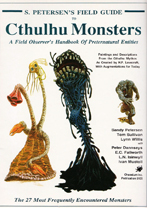 authors: Sandy Petersen with Lynn Willis
authors: Sandy Petersen with Lynn Willis
interior artists: Tom Sullivan
cover artist: Tom Sullivan
publisher: Chaosium Inc.
publication date: 1988
cover: softcover
number of pages: 64
ISBN: 0-933635-48-6
description: This field guide is subtitled, A Field Observer's Handbook of Preternatural Entities and notes on the cover that it contains, "Paintings and Descriptions from the Cthulhu Mythos As Created by H.P. Lovecraft, With Augmentations for Today". This book includes entries on twenty-seven creatures from the works of H.P. Lovecraft.
Our featured entry from this bestiary is the Great Race of Yith.
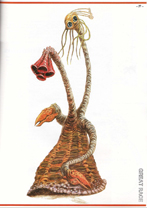 "The essence was always the same--a person of keen thoughtfulness seized with a strange secondary life and leading for a greater or lesser period an utterly alien existence typified at first by vocal and bodily awkwardness, and later by a wholesale acquisition of scientific, historic, artistic, and anthropological knowledge, an acquisition carried on with feverish zest and with a wholly abnormal absorptive power."
"The essence was always the same--a person of keen thoughtfulness seized with a strange secondary life and leading for a greater or lesser period an utterly alien existence typified at first by vocal and bodily awkwardness, and later by a wholesale acquisition of scientific, historic, artistic, and anthropological knowledge, an acquisition carried on with feverish zest and with a wholly abnormal absorptive power."
- H.P. Lovecraft.
This creature has a large conical body topped by four long tentacles ending in a variety of useful organs. It is intelligent and long-lived.
The human discoverer of the Great Race (peaslee, 1936) has discussed at length systematic and long-ranged Great Race researches into natural history, psychology, and temporal physics. Given their intellecutualism and moderation, the reader might think of the Great Race as so many placid monks, were he or she to ignore the species' genocidal invasions and ferocious Earthly wars.
The Great Race is so-named because it conquered time. It developed the ability to send minds across eons to take over the bodies of other beings...
|
|
|
|
|
September 17, 2016
S. Petersen's Field Guide to Creatures of the Dreamlands
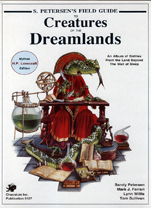 authors: Sandy Petersen with Lynn Willis
authors: Sandy Petersen with Lynn Willis
interior artists: Mark J. Ferrari and Tom Sullivan
cover artist: Mark J. Ferrari
publisher: Chaosium Inc.
publication date: 1989
cover: softcover
number of pages: 64
ISBN: 0-933635-53-2
description: This field guide is subtitled, An Album of Entities from the Land Beyond the Wall of Sleep, and contains entries on twenty-six creatures from the Dreamlands of H.P. Lovecraft. Five of the most infamous creatures of the Dreamlands--the ghast, ghoul, moon-beast, nightgaunt and shantak--are not included in this field guide, as they were included in a previous book, S. Petersen's Field Guide to Cthulhu Monsters.
Our featured entry from this bestiary is the blupe.
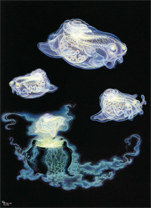 "...Whole worlds of matter, energy, and life...lie close at
hand yet can never be detected with the senses we have....
Such strange, inaccessible worlds exist at our very elbows."
"...Whole worlds of matter, energy, and life...lie close at
hand yet can never be detected with the senses we have....
Such strange, inaccessible worlds exist at our very elbows."
- H.P. Lovecraft.
It is a small semi-transparent entity. elliptical in shape, which floats
through the air. A Blupe has a clear, clean odor, like that after a
fierce storm. Its translucent internal organs are visible through its
skin. In the dark, it glows with a crystalline sheen.
Habitat: The Blupe is not found naturally anywhere outside the
Dark Dimension, an opaline plane where light radiates as blackness,
and shadows have wavelengths. Controlled obsession now brings
Blupes to Earth as it long has to the Dreamlands.
The Blupe prefers moist surroundings. Once summoned to
Earth or Earth's Dreamlands, it slowly dehydrates, rarely surviving
for more than 10-15 days. Its useful lifetime can be greatly
prolonged by careful regulation of temperature and humidity, or by
keeping it underwater (Dannseys, 1988). No Blupe has been
successfully bred away from the Dark Dimension.
Distribution: this animal is found in the Cire Enicar area of the
Dark Dimension (Webber coordinates W.2880, X.84604, Y .375,
Z.9678) and in the liquescences surrounding it. There the
atmosphere is almost pure water vapor; researchers must carry air
supplies.
|
|
|
|
|
September 18, 2016
S. Petersen's Field Guide to Lovecraftian Horrors
 authors: Sandy Petersen with Lynn Willis
authors: Sandy Petersen with Lynn Willis
interior artists: Mark J. Ferrari and Tom Sullivan
cover artist: Mark J. Ferrari
publisher: Chaosium Inc.
publication date: December, 2015
cover: hardcover
number of pages: 128
ISBN: 978-1-56882-083-5
description: This field guide is subtitled, A Field Observer's Handbook of Preternatural Entities and Beings from Beyond the Wall of Sleep, and contains entries on fifty-three creatures from the works of H.P. Lovecraft. This book contains all entries from S. Petersen's Field Guide to Cthulhu Monsters (1988) and S. Petersen's Field Guide to Creatures of the Dreamlands (1989). The text remains the same but the all illustrations are new.
Our featured entry from this bestiary is Yog-Sothoth.
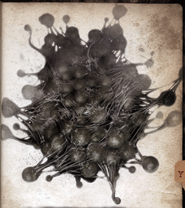 "The Old Ones were, the Old Ones are, and the Old Ones shall be. Not in the spaces we know, but between them, they walk serene and primal, undimensioned and to us unseen. Yog-Sothoth knows the gate. Yog-Sothoth is the gate. Yog-Sothoth is the key and guardian of the gate. Past, present, future, all are one in Yog-Sothoth. He knows where the Old Ones broke through of old, and where They shall break through again. He knows where They have trod earth's fields, and where They still tread them, and why no one can behold Them as They tread...As a foulness shall ye know Them. Their hand is at your throats, yet ye see Them not; and Their habitation is even one with your guarded threshold."
"The Old Ones were, the Old Ones are, and the Old Ones shall be. Not in the spaces we know, but between them, they walk serene and primal, undimensioned and to us unseen. Yog-Sothoth knows the gate. Yog-Sothoth is the gate. Yog-Sothoth is the key and guardian of the gate. Past, present, future, all are one in Yog-Sothoth. He knows where the Old Ones broke through of old, and where They shall break through again. He knows where They have trod earth's fields, and where They still tread them, and why no one can behold Them as They tread...As a foulness shall ye know Them. Their hand is at your throats, yet ye see Them not; and Their habitation is even one with your guarded threshold."
- H.P. Lovecraft.
In our dimensions the transcosmic entity known as Yog-Sothoth appears as a conglomeration of iridescent globes. These globes undergo continuous motion and reorganization, shifting, flowing into one another, and breaking up to coalesce again. The globes are not always attached to one another, and may spread over quite a large area.
Even primitively-equipped investigators can contact Yog-Sothoth. However, this entity is notoriously dangerous, and non-specialists should avoid contact. Prolonged or indeterminate contact with Yog-Sothoth has been demonstrated to be deleterious to the local continuum (Fallworth, 1928).
|
|
|
|
|
September 19, 2016
Monster Vault: Threats to the Nentir Vale
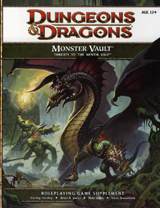 authors: Sterling Hershey, Brian R. James, Matt James & Steve Townshend
authors: Sterling Hershey, Brian R. James, Matt James & Steve Townshend
interior artists: Peter Bergting et al.
cover artist: Steve Prescott
publisher: Wizards of the Coast
publication date: 2011
cover: softcover
number of pages: 128
ISBN: 978-0-7869-5838-2
description: This book contains 40 entries, many with multiple examples, of beasts that can be found in the Nentir Vale, a campaign setting of the 4th edition of Dungeons and Dragons.
Our featured entry from this bestiary is the mooncalf.
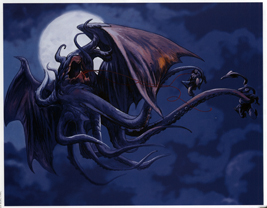 Mooncalves are otherwordly monstrosities from the Far Realm that haunt the spaces between worlds. Following some little-understood cycle, they enter the world for a period of weeks, lairing atop desolate mountains and lonely hills, often near settlements where food is abundant.
Mooncalves are otherwordly monstrosities from the Far Realm that haunt the spaces between worlds. Following some little-understood cycle, they enter the world for a period of weeks, lairing atop desolate mountains and lonely hills, often near settlements where food is abundant.
Ringed by mountains and dotted with hills, the Nentir Vale remains a favorite location for the predatory mooncalves. Sages of Nerath used to predict with great accuracy the arrival of these horrific beasts, but much of that knowledge has been lost since Nerath's fall.
A mooncalf combines the body of an immense cephalopod with the wings of a bat. It has six short tentatcles and that it uses to grab prey and two long, flailing tentacles that it uses to attack at a distance. The creature's beak-like mouth is located with the tentacles meet the base of its body.
|
|
|
|
|
September 20, 2016
Arthur Spiderwick's Field Guide to the Fantastical World Around You
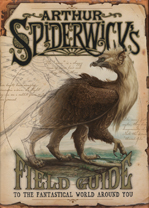 author: Holly Black
author: Holly Black
interior artist: Tony DiTerlizzi
cover artist: Tony DiTerlizzi
publisher: Simon & Schuster Books
publication date: 2005
cover: hardcover
number of pages: 121
ISBN: 978-0689859410
description: This bestiary contains 31 entries and is written by the in-world author, Arthur Spiderwick.
Our featured entry from this bestiary is the common house boggart.
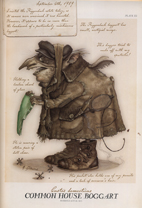 Abuse of a brownie, either through neglect of chores, failure to leave out food, or deliberate insult, will it into a boggart.
Abuse of a brownie, either through neglect of chores, failure to leave out food, or deliberate insult, will it into a boggart.
Also known as bogans or bogies, boggarts delight in tormenting those they once protected and will cause milk to sour, doors to slam, dogs to go lame, and other mischief.
Boggarts particularly like to steal food and to hide household items like keys and socks. More common than brownies, boggarts reside in many houses and workplaces. This may be the result of decades of improper treatment of brownies, which were once far more prevalent.
|
|
|
|
|
September 26, 2016
Midgard Bestiary
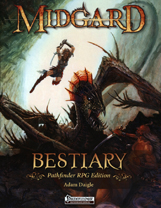 author: Adam Daigle
author: Adam Daigle
interior artist: various
cover artist: Aaron Miller
publisher: Open Design/Kobold Quarterly
publication date: 2012
cover: softcover
number of pages: 108
ISBN: 978-1936781133
description: This bestiary contains entries from Open Design projects and Kobold Quarterly issues. These creatures exist in the Midgard Campaign Setting. The statistics have been converted to the Pathfinder RPG.
Our featured entry from this bestiary is the goblin shark.
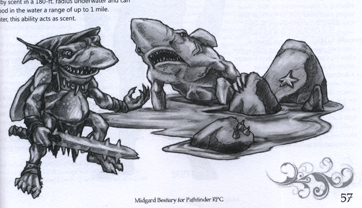 A four-foot-tall goblin emerges from the waves and crawls along the shore, shedding its shark-like form and grinning with an impossibly wide mouth filled with rows of sharp teeth.
A four-foot-tall goblin emerges from the waves and crawls along the shore, shedding its shark-like form and grinning with an impossibly wide mouth filled with rows of sharp teeth.
Incredibly ugly and unnerving, these gilled goblins are both larger and leaner than their terrestrial cousins, possessing a protruding shelf of a nose that overhangs a wide mouth filled with multiple rows of razored, triangular teeth. Their nose cartilage forms a hard protuberance that grants them a keen sense of smell. Able to take the shape of equally ugly shark-like creatures, packs of goblin sharks patrol shallow coral reefs in search of food while terrorizing fishermen and merchant ships. While intellectually unimpressive on their own, goblin sharks are natural pack hunters and possess a collective cunning when engaged in group hunts. Entire tribes dwell in caves carved from dead reefs or within the sunken ruins of forgotten empires. Areas that host such a tribe are typically filthy and polluted.
Like their land-bound cousins, goblin sharks are quite superstitious, frequently following the guidance of their eldest kill-shaman in the ways of their gods.
|
|
|
|
|
October 9, 2016
The Basic Fantasy Field Guide of Creatures Malevolent and Benign
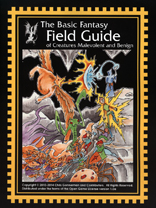 author: Chris Gonnerman et al.
author: Chris Gonnerman et al.
interior artists: various
cover artist: uncredited
publisher: Basic Fantasy
publication date: 2014
cover: softcover
number of pages: 84
ISBN: 978-1503347250
description: This bestiary contains entries for 180 creatures. The statistics in this book are compatible with the Basic Fantasy RPG.
Our featured entry from this bestiary is the gump.
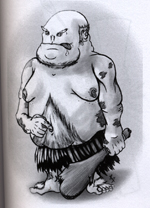 Gumps are large blubbery humanoids that stand just over a head taller than a man, with a broad, jagged toothed grin and small deep-set eyes. Meeting the gaze of a gump is dangerous. Anyone who meets the gaze of a gump must save vs Paralysis at +2 or suffer the effects of a Hold Person spell for 1d4+1 rounds. Anyone facing a gump in combat is deemed to have met its gaze, as is anyone who is surprised by the monster...
Gumps are large blubbery humanoids that stand just over a head taller than a man, with a broad, jagged toothed grin and small deep-set eyes. Meeting the gaze of a gump is dangerous. Anyone who meets the gaze of a gump must save vs Paralysis at +2 or suffer the effects of a Hold Person spell for 1d4+1 rounds. Anyone facing a gump in combat is deemed to have met its gaze, as is anyone who is surprised by the monster...
Gumps communicate with an odd jibbering and slobbery voice that is difficult to understand. They can also speak Common and the languages of goblinoid creatures.
|
|
|
|
|
October 13, 2016
Advanced Bestiary, d20 Edition
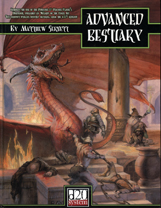 author: Matthew Sernett
author: Matthew Sernett
interior artists: Ilya Astrakhan et al.
cover artist: William C. Eaken
publisher: Green Ronin Publishing
publication date: 2004
cover: hardcover
number of pages: 256
ISBN: 978-1932442168
description: This bestiary contains templates to alter beasts according to 100 new templates. The statistics in this book are compatible with the d20 system.
Our featured entry from this bestiary is a triceratops to which the manimal template has been applied.
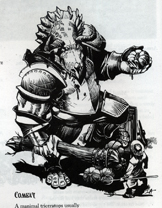 Somewhere between human and animal lies the manimal. Some say that these creatures are the abominable results of sorcerous crossbreeding between humans and animals. Others speak of bizarre druidic rites that gave give animals human forms.
Somewhere between human and animal lies the manimal. Some say that these creatures are the abominable results of sorcerous crossbreeding between humans and animals. Others speak of bizarre druidic rites that gave give animals human forms.
A manimal is an animal-like creature with a humanoid shape and intellect. A manimal has two legs to walk upon and two arms with hands that can manipulate tools. Manimals are often mistaken for lycanthropes--more powerful creatures whose origins are lost to time.
Manimal Triceratops: This massive reptilian creature stands 20 feet tall and weighs almost 20,000 pounds. Three long horns project from its frilled head, and its small eyes glimmer with a mean intelligence.
The manimal triceratops is short-tempered and aggressive. It uses its great size and strength to force other creatures to do its labor and often enslaves weaker creatures to work on vast plantations. Sometimes a settlement of weaker creatures can bargain with a manimal triceratops, offering food and shelter for its protection of the town, but the manimal often asks for too much or boorishly takes what it wants from farmers' fields and merchants' market stalls, regardless of any bargain it made.
|
|
|
|
|
October 18, 2016
Advanced Bestiary, Pathfinder Edition
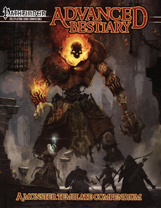 author: Jeffrey Hersh
author: Jeffrey Hersh
interior artists: various
cover artist: Svetoslav Petrov
publisher: Green Ronin Publishing
publication date: 2014
cover: hardcover
number of pages: 312
ISBN: 978-1934547595
description: This bestiary contains recipes to alter beasts according to over one hundred templates. The statistics in this book are compatible with the Pathfinder system. The content of this book is revised and expanded from the d20 Edition of the Advanced Bestiary (2004). The illustrations are all new.
Our featured entry from this bestiary is Yg'photh the Sky Tyrant, an aboleth to which the airborne template has been applied.
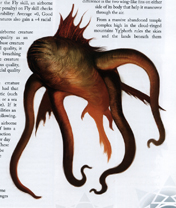 Not all creatures of the ocean depths are restricted to dark, watery lairs. A few are found in the most unexpected of places--high mountain caverns, deep forest grottos, and languorously soaring amongst the clouds in the sky.
Not all creatures of the ocean depths are restricted to dark, watery lairs. A few are found in the most unexpected of places--high mountain caverns, deep forest grottos, and languorously soaring amongst the clouds in the sky.
An airborne creature is a creature that has, either through the natural forces of evolution or via permanent magical change, gained the ability to breathe air and to "swim" through air as their cousins do in the seas, lakes and rivers. Indeed, it controls air itself, allowing it to move freely, and buffet those that dare oppose its mastery of the skies. Airborne creatures have goals, motivations and instincts not unlike those of their aquatic cousins--an airborne shark is a top tier predator, swimming between trees as it chases a deer through the forest, and an airborne dragon turtle vie with its red and gold dragon cousins for the best lairs and choicest treasures.
Yg'photh the Sky Tyrant is, thankfully, the only known airborne aboleth. It is a massive creature, 30-feet long and weighing around six tons. Though Yg'photh is not surrounded by the typical mucus cloud of its aquatic kin, it looks like most any other aboleth, with four scaly tentacles on the sides of its fish-like body and three slit-like red eyes at the front of its head. The most significant difference is the two wing-like fins on either side of its body that help it maneuver through the air.
From a massive abandoned temple complex high in the cloud-ringed mountains, Yg'photh rules the skies and land beneath them for many miles around. Much as its aquatic cousins do in the dark depths of the seas and water-logged caverns, Yg'photh has used its spell-like abilities to create numerous slaves to serve its purposes, surrounding itself with guards, messengers, and general servants.
|
|
|
|
|
October 20, 2016
GURPS Fantasy Bestiary, 3rd Edition
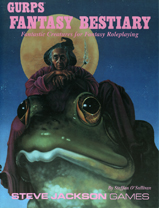 author: Steffan O'Sullivan et al.
author: Steffan O'Sullivan et al.
interior artist: Thomas Baxa
cover artist: Carol Heyer
publisher: Steve Jackson Games
publication date: 1999
cover: softcover
number of pages: 128
ISBN: 978-1556341847
description: This bestiary contains more than 250 fantasy animals and plants. It is compatible with third edition GURPS (Generic Universal Role Playing System) rules.
Our featured entry from this bestiary is the mushroom ogre.
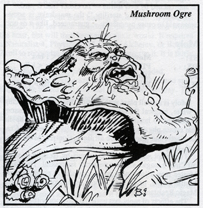 The mushroom ogre is a fungus that eats people and animals. It starts small , growing at the root of a gallows tree. After 2 weeks, it is about 6" high; it uproots itself and becomes a carnivore, growing very quickly (6 months to full size). At first it eats mice and birds, then rabbits, cats, dogs and finally people, which it reaches its full growth...
The mushroom ogre is a fungus that eats people and animals. It starts small , growing at the root of a gallows tree. After 2 weeks, it is about 6" high; it uproots itself and becomes a carnivore, growing very quickly (6 months to full size). At first it eats mice and birds, then rabbits, cats, dogs and finally people, which it reaches its full growth...
A dead mushroom ogre should be burned to keep it from releasing spores. The bases of gallows-trees (including living grees used as hanging sites) should be checked regularly to prevent the growth of these horrors.
|
|
|
|
|
October 29, 2016
The Book of Fiends
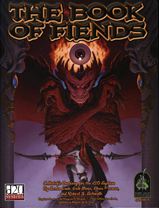 author: Aaron Loeb, Erik Mona, Chris Pramas and Robert J. Schwalb
author: Aaron Loeb, Erik Mona, Chris Pramas and Robert J. Schwalb
interior artist: Kevin Crossley et al.
cover artist: Michael Sutfin
publisher: Green Ronin Publishing
publication date: 2003
cover: hardcover
number of pages: 224
ISBN: 978-1932442090
description: This bestiary contains more than 130 devils, daemons and demons. The entries for the devils are taken from Legions of Hell. Book of Fiends. Volume One (2001) and the entries for the demons are taken from Armies of the Abyss. Book of Fiends. Volume Two (2002). The entries for the daemons are new material. The stat blocks for the devils and demons have been updated to the d20 (3.5 edition) rules.
Our featured entry from this bestiary is the Lieutenant of the Company, a member of the Society of the Companions of Malice.
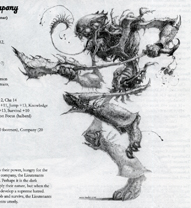 Even Gehenna has its traditions. In the swirling madness of the war between Hell and the Abyss, the Companions of Malice are among the most feared and valued warriors. A mercenary company in the service of Tyrexxus that has fought on every side of the conflict over the Millennia, the Companions of Malice obey one law and one law only; they will faithfully serve their employer.
Even Gehenna has its traditions. In the swirling madness of the war between Hell and the Abyss, the Companions of Malice are among the most feared and valued warriors. A mercenary company in the service of Tyrexxus that has fought on every side of the conflict over the Millennia, the Companions of Malice obey one law and one law only; they will faithfully serve their employer.
The Companions accept commissions for their services for only one mission at a time. During particularly brutal periods of the eternal war they have engendered frenzied bidding wars between demons and devils, switching sides in the conflict with each new battle. However, once they have accepted a commission, they are unshakeable.
Lieutenant of the Company: Highly protective of their positions, arrogant in their power, hungry for the glory of battle and for greater status within in the company, the Lieutenants of the Company evidence cunning and ferocity. Perhaps it is the dark enchantment of the company, perhaps it is simply their nature, but when the Companions take on a new foe, the lieutenants develop a supreme hatred. While most mercenaries seek only to do their job and survive, the Lieutenants take it upon themselves to destroy their opponents utterly.
To this end, the lieutenants command their footmen into battle. Each lieutenant oversees a unit of 20 footmen. Bearing aloft their shining, black halberds--the symbol of their office--the lieutenants loose hideous battle cries that move their soldiers to frenzied heights of destruction and strike terror in the hearts of their foes.
|
|
|
|
|
October 30, 2016
Nyambe: African Adventures
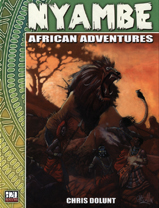 author: Chris Dolunt
author: Chris Dolunt
interior artist: various
cover artist: Mike Dutton
publisher: Atlas Games
publication date: 2002
cover: hardcover
number of pages: 256
ISBN: 978-1589780231
description: This book is a complete campaign sourcebook for a continent called Nyambe-tanda, a place that combines African mythology, legend and history with elements of high fantasy. The book contains new races, core class variants, spells, diseases, magic items and, relevant to this survey of bestiaries, a fifty-nine page chapter focusing on monsters, animals, vermin and monster templates of Nyambe. It is compatible with the d20 system of rules.
Our featured entry from this bestiary is the ndalawo.
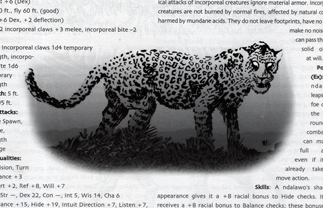 Also known as a shadow leopard, the ndalawo (n-DAH-lah-woh) is a leopard that has been transformed into an undead shadow. Though they prefer to prey on other leopards, perpetuating their foul species, they occasionally attack humanoids as well.
Also known as a shadow leopard, the ndalawo (n-DAH-lah-woh) is a leopard that has been transformed into an undead shadow. Though they prefer to prey on other leopards, perpetuating their foul species, they occasionally attack humanoids as well.
The ndalawo prefers to attack with surprise. If it is unable to do, it will usually wait until a more opportune moment presents itself. Despite its caution, the creature is not cowardly, and rarely retreats once combat is joined.
|
|
|
|
|
November 12, 2016
Monsternomicon. Volume II. The Iron Kingdoms and Beyond
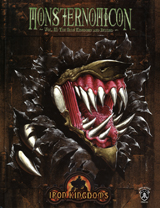 authors: Brian Snoddy, Matt Wilson et al.
authors: Brian Snoddy, Matt Wilson et al.
interior artists: Brian Snoddy
cover artist: Brian Snoddy
publisher: Privateer Press
publication date: April, 2007
cover: hardcover
number of pages: 240
ISBN: 978-1-933362-17-5
description: This bestiary is for use with the Iron Kingdoms setting. It is compatible with the 3.5th version of the d20 system.
Our featured entry from this bestiary is the quelvitar, an infernal.
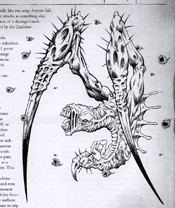 As she described these horrifying creatures, Sybeth went to great pains to caution me against ever feeling confident in my appraisal of an infernal. The curators and executors work souls like clay and can mold conscriptus into any form with any powers the creators can conceive. Thus conscriptus are weapons more so than any natural creature. By way of example she described the Quelvitar, or "soul gnawer".
As she described these horrifying creatures, Sybeth went to great pains to caution me against ever feeling confident in my appraisal of an infernal. The curators and executors work souls like clay and can mold conscriptus into any form with any powers the creators can conceive. Thus conscriptus are weapons more so than any natural creature. By way of example she described the Quelvitar, or "soul gnawer".
A swift and elusive conscriptus, the Quelvitar falls more easily to concentrated effort than the Quavash, yet it can evade its enemies and engage on its own terms. It stalks conflicts as an assassin to bring death or ruin to its chosen prey. The Quelvitar's role on infernal battlefields holds less interest than the threat it possesses on Caen at the behest of infernalists who arrange for it to track down and slaughter their own enemies.
The Quelvitar can cross walls or ceilings with equal alacrity and can leap tremendous distances. The air shimmers darkly about them, and flickering echoes appear ahead or behind them to disguise their exact location. Shadows quickly enfold them and unless one focuses fully they can vanish entirely, reappear from some unexpected quarter, and deliver a swift, painful death.
A strange swarm of flying spiritual parasites surrounds the Quelvitar like flies. These fragments of soul-stuff or life essence, perhaps more ghastly than the infernal itself, take the shape of hungry disembodied mouths. Only the sound of their gnashing teeth heralds the Quelvitar's movements. These parasites latch onto the infernal's prey as it attacks and chew on the very soul of the person to cause singular agony and nauseating disorientation. They apparently cannot cause actual harm to an immortal soul, which would not suit the Quelvitar's purposes, but they do prove a loathsome distraction and add to the horror of any attack by these otherworldly creatures.
|
|
|
|
|
November 14, 2016
Draconomicon, 2nd Edition
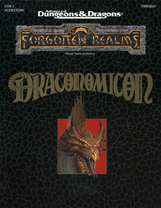 authors: Nigel Findley et al.
authors: Nigel Findley et al.
interior artists: Lars Grant/West
cover artist: Brom and Todd Lockwood
publisher: TSR
publication date: 1990
cover: softcover
number of pages: 128
ISBN: 978-0880-388764
description: This bestiary of dragons is for use with the 2nd edition of Dungeons and Dragons.
Our featured entry from this bestiary is the dracohydra.
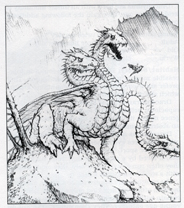 Dracohydras are hideous, multiheaded winged monsters that combine the worst features of dragons and hydras. No one knows precisely what their origin is. Some sages believe they're ancient offshoots of the pre-dragons that have been hibernating for millions of years; others believe they're the next step in the evolution of dragons; still others think that they're the result of tampering by supernatural beings--perhaps deities, or perhaps Tiamat the Chromatic Dragon.
Dracohydras are hideous, multiheaded winged monsters that combine the worst features of dragons and hydras. No one knows precisely what their origin is. Some sages believe they're ancient offshoots of the pre-dragons that have been hibernating for millions of years; others believe they're the next step in the evolution of dragons; still others think that they're the result of tampering by supernatural beings--perhaps deities, or perhaps Tiamat the Chromatic Dragon.
Dracohydras have been reported with two to five heads. Twenty-five percent of dracohydras have two heads, 50% have three heads, 15% have four heads and 10% have five heads.
The creatures are a muddy brown color, ranging to a lighter brown, almost cream, on their bellies. Their eyes are red.
Dracohydras speak their own tongue, a derivative of the language of evil dragons. Dracohydras can understand about half of what evil dragons say, and vice versa. Dracohydras know no other languages.
|
|
|
|
|
November 15, 2016
I, Tyrant
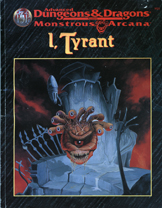 designer: Aaron Allston
designer: Aaron Allston
interior artists: Arnie Swekel et al.
cover artist: Dana Knutson
publisher: TSR
publication date: 1996
cover: softcover
number of pages: 96
ISBN: 978-0786-904044
description: This book is devoted to all types of beholders and related creatures. It is for use with the 2nd edition of Dungeons and Dragons.
Our featured entry from this bestiary is the death tyrant.
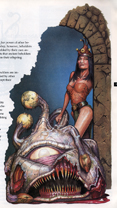 When most people refer to "undead beholders", they mean death tyrants. Death tyrants are created through the use of a magical spell cast upon the bodies of slain beholders. This spell also defines the medium through which the death tyrants receive orders (a spell, controlling mechanism, or code-word, for example).
When most people refer to "undead beholders", they mean death tyrants. Death tyrants are created through the use of a magical spell cast upon the bodies of slain beholders. This spell also defines the medium through which the death tyrants receive orders (a spell, controlling mechanism, or code-word, for example).
A death tyrant looks much like a beholder with several important differences. Oftentimes, the death tyrants bear horrible gaping wounds encrusted with mold and other signs of decay. In addition, some of their eyestalks may be missing and other may not move. When not in combat, a death tyrant's eyestalks hang limp. Finally, a milky film covers their central eyes; occasionally this film will seep out of the death tyrant's eye.
Death tyrants are slower than normal beholders and when not following orders, the levitate in place until they detect movement. These foul creatures smell strongly of decay and cannot communicate in any way.
|
|
|
|
|
November 16, 2016
Volo's Guide to Monsters
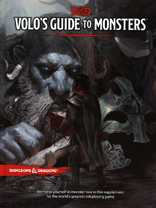 lead designer: Mike Mearls
lead designer: Mike Mearls
interior artists: various
cover artist: Tyler Jacobson
publisher: Wizards of the Coast
publication date: November, 2016
cover: hardcover
number of pages: 224
ISBN: 978-0786-966011
description: This book contains a chapter with extensive coverage of nine types of beasts as well as a bestiary with 127 entries. It is for use with the 5th edition of Dungeons and Dragons.
Our featured entry from this bestiary is the grung.
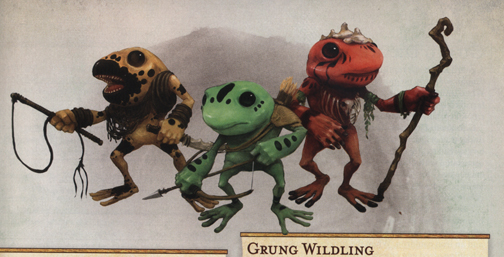 Grungs are aggressive froglike humanoids found in rain forests and tropical jungles. They are fiercely territorial and see themselves as superior to most other creatures.
Grungs are aggressive froglike humanoids found in rain forests and tropical jungles. They are fiercely territorial and see themselves as superior to most other creatures.
Tree-Dwelling Amphibians. Grungs live in trees and prefer shade. A grung hatchery is maintained in well-guarded ground-level pools. About three months after hatching, a grung tadpole takes on the shape of an adult. It takes another six to nine months for a grung juvenile to reach maturity.
Castes and Colors. Grung society is a caste system. Each caste lays eggs in a separate hatching pool, and juvenile grungs join their caste upon emergence from the hatchery. All grungs are a dull greenish gray when they are born, but each individual takes on the color of its caste as it grows to adulthood.
Green grungs are the tribe's warriors, hunters and laborers, and blue grungs work as artisans and in other domestic roles. Supervising and guiding both groups are purple grungs, which serve as administrators and commanders...
Red grungs are tribe's scholars and magic users. They are superior to purple, blue and green grungs and given proper respect even by grungs of higher status...
Higher castes include orange grungs, which are elite warriors that have authority over all lesser grungs, and gold grungs, which hold the highest leadership positions. A tribe's sovereign is always a gold grung...
Naturally Toxic. All grungs secrete a substance that is harmless to them but poisonous to other creatures. A grung also uses venom to poison its weapons.
|
|
|
|
|
November 26, 2016
The Sea Devils
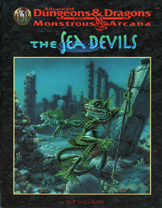 designer: Skip Williams
designer: Skip Williams
interior artists: Arnie Swekel et al.
cover artist: Paul Jacquays
publisher: TSR
publication date: 1997
cover: softcover
number of pages: 96
ISBN: 978-0786-906437
description: This book is devoted to all aspects of the culture of sahuagins, evil denizens of the depths. It is for use with the 2nd edition of Dungeons and Dragons.
Our featured entry from this bestiary is the sahuagin.
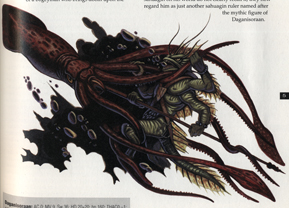 Also known as "Sea Devils" and the "Devil Men of the Deep", sahuagin are marine humanoids who dwell in coastal seas. Although found in temperate climes, they prefer fairly warm waters and do not permanently reside in places where the surface water temperature is less than 60 degrees Fahrenheit year round. In fact, their presence in high latitudes is almost always the result of warm currents.
Also known as "Sea Devils" and the "Devil Men of the Deep", sahuagin are marine humanoids who dwell in coastal seas. Although found in temperate climes, they prefer fairly warm waters and do not permanently reside in places where the surface water temperature is less than 60 degrees Fahrenheit year round. In fact, their presence in high latitudes is almost always the result of warm currents.
About one in every 216 hatchlings possesses four useable arms. The extra set of claws gives the mutant a decided edge when competing with other hatchlings for food and space. The sahuagin admire these mutants' fighting prowess and usually suffer them to live--provided they show no other defects...
Sahuagin can exchange information over enormous distances through a communal vocalization known as deepsong. Creating deepsong requires considerable preparation and leaves the participants temporarily exhausted. The sahuagin seldom use it except when they are sure of their own security throughout the process. Because of its limits, deepsong proves unsuitable as a means of spreading an alarm; the sea devils usually dispatch swimmers to accomplish this task. Once begun, however, deepsong can read for miles, allowing for quick communications between widely scattered communities. Thus deepsong is an ideal medium for spreading news of a victory or calling the sea devils together for raiding or war...The singers decide what types of creatures they will contact through deepsong. Only those creatures can understand the message contained in the deepsong. Other creatures simply note the song as an unsettling murmur with an unidentifiable source.
Sekolah. This voracious deity rules over the realm of Sheyruushk, in Stygia (a layer of Baator). Even the baatezu respect his indomitable ferocity and give him wide berth. The sahuagin worship Sekolah as a personification of uncaring viciousness and brutality--qualities they admire. They credit Sekolah for granting them the gift of fertility, which allows them to pursue their goals of plunder, dominion and racial purity without fearing for their continued existence.
|
|
|
|
|
November 27, 2016
Villain Codex
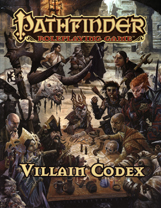 lead designer: Jason Bulmahn
lead designer: Jason Bulmahn
interior artists: various
cover artist: Wayne Reynolds
publisher: Wizards of the Coast
publication date: November, 2016
cover: hardcover
number of pages: 256
ISBN: 978-1601-259066
description: This book contains a background information and entries for numerous members of twenty villainous organizations, including an arcane society, carnival troupe, diabolical church, merry outlaws and scandalous pirates, etc. It is for use with the Pathfinder RPG.
Our featured entry from this bestiary is the wrathbringer, a fungus leshy skald, and a member of Nature's Scourge, an organization bent on cleansing the world of the taint of civilization.
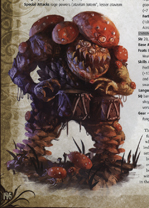 The members of Nature's Scourge take their respect for the power and beauty of nature to an extreme. Some of them believe that living things reach the peak of their existence when they embrace their primal instincts. These members may see themselves as teachers or guides for those weakened by the taint of civilization, or they may embrace more selfish motives.
The members of Nature's Scourge take their respect for the power and beauty of nature to an extreme. Some of them believe that living things reach the peak of their existence when they embrace their primal instincts. These members may see themselves as teachers or guides for those weakened by the taint of civilization, or they may embrace more selfish motives.
The Blight Caller created the Wrathbringer--once a fungus leshy imbued with emotions--several years ago, when the druid discovered that the delicate fungi of the leshy's grove were being poisoned by the waste of nearby settlements. The Blight Caller gave the leshy a new body, but doing so required him to give a small piece of his own spirit as well. This sacrifice formed a connection between the druid and the leshy and imbued the leshy with the rage against civilization that burned so strongly in the druid's heart.
|
|
|
|
|
November 28, 2016
The Illithiad
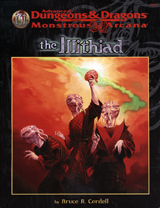 designer: Bruce R. Cordell
designer: Bruce R. Cordell
interior artists: Glen Michael Angus et al.
cover artist: Fred Fields
publisher: TSR
publication date: 1998
cover: softcover
number of pages: 96
ISBN: 978-0786-912063
description: This book is devoted to all types of illithids (mind flayers) and related creatures. It is for use with the 2nd edition of Dungeons and Dragons.
Our featured entry from this bestiary is the illithid vampire.
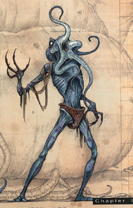 Vampiric mind flayers possess the abilities and powers of both vampires and illithids. Although of animal intelligence, illithid vampires retain the use of the mind blast psionic attacks; they use the power to stun their prey before charging into melee.
Vampiric mind flayers possess the abilities and powers of both vampires and illithids. Although of animal intelligence, illithid vampires retain the use of the mind blast psionic attacks; they use the power to stun their prey before charging into melee.
Each of an illithid vampire's four tentacles can attack in one round, inflicting 1d6+4 points of damage per successful strike and draining two life energy levels per tentacle from the victim. Every round a tentacle retains its grasp upon a victim, the creature automatically loses the appropriate number of life energy levels.
Whenever an illithid vampire drains life energy, it heals 2d8 points of damage. The regenerative ability is so effective that even reducing a vampiric mind flayer's body to ashes does not destroy the creature. The only way to ensure destruction is to separate the ashes into portions and seal each portion away from the others. If these separated piles of ash ever reunite, the illithid vampire will soon reform to spread its terror.
Vampiric mind flayers require gray matter as well as blood to remain active, and they use methods similar to their living relatives to extract brains--although brute undead strength replaces the action of flesh-dissolving enzymes.
|
|
|
|
|
December 3, 2016
The Bestiary
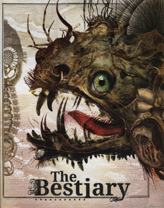 editor: Ann VanderMeer
editor: Ann VanderMeer
authors: Reza Negarestani et al.
interior artist: Ivica Stevanovic
cover artist: Ivica Stevanovic
publisher: Centipede Press
publication date: December, 2015
cover: hardcover
number of pages: 280
ISBN: 978-1-61347-133-1
description: This book contains 28 short stories, each written by a different author, about a particular beast.
Our featured entry from this bestiary is the nothus barathruma.
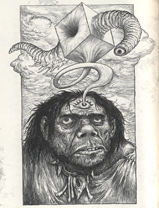 In the cosmology of the Tadmurian barbers, the world is cleared of all taxonomic ranks. Categorical traits do not exist and species are superstitions of a few energumen. As a result, the Tadmurians do not recognize any species save for one cursed beast.
In the cosmology of the Tadmurian barbers, the world is cleared of all taxonomic ranks. Categorical traits do not exist and species are superstitions of a few energumen. As a result, the Tadmurians do not recognize any species save for one cursed beast.
"It," I was told by the barbarians, "comes into existence whenever the headless nature stares into itself for a negligible bit longer than it usually does in order to realize itself." They say that nature is a stale abyss, it does not have anything to offer other than its own unimaginative self that we all partake in. "Nature," they add "has the occasional habit of fixating upon itself as there is nothing else beyond it to stare upon."
Once nature introspects gawkily, its panoramic blindness turns into an intrusive short-sightedness, its depth develops into a local chasm whereby it can experience itself from a viewpoint, a perspective at last. This whimsical habit becomes and unruly obsession when nature litters space with multiple perspectives by opening localized chasms from which it can stare into itself. Each of these self-inflected cuts is an aperture that puts something into perspective, begetting a viewpoint, a subject, a thing. But the barbarians warned me, "nature, sporadically, might frequent one of the apertures too often or excessively cutting chasms within chasms in order to impregnate viewpoints within viewpoints, a terrible habit of self-reflection through imbricate cuts and nested ruptures." On such occasions, the ulcerous and overused perspective might begin to see itself differently or even independently of the wounds that have brought it forth and the nature that myopically sees through it. Barbarians pray for those who are born by the abyss peering into itself and mourn for the wretched who mistake the self-stalking gaze of nature as their own.
Nothus barathruma, the chance-hole, or more accurately, the abyss cut into the face of the dice is the one and only thing to which the Tadmurian barbers assign taxonomic distinctions and recognize as a species. To them, nothus barathruma is that cursed thing unfortunate enough to be beasted and categorized out of the immeasurable heap of nature. Universal nature, the barbarians hold, is a dice with infinite faces. As it rolls aimlessly, it calls into existence the possible states of the world. On each face, there is a dent, a shallow hole, a cut or a wound from which the all-alienated nature who is even mindless to its own existence peers into its blankness in order to obtain scarce clues as to what it is...
|
|
|
|
|
December 4, 2016
Rappan Athuk: A Dungeon of Graves Bestiary
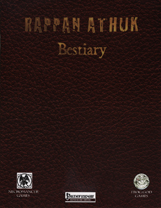 authors: John State, Gary Schotter and Jeff Harkness
authors: John State, Gary Schotter and Jeff Harkness
interior artist: N.A.
cover artist: Charles A. Wright
publisher: Frog God Games & Necromancer Games
publication date: 2012
cover: softcover
number of pages: 29
ISBN: None
description: This book contains entries for twenty-eight beasts and three templates for use in the Rappan Athuk mega-dungeon. It is compatible with the Pathfinder RPG. The book does not contain any illustrations.
Our featured entry from this bestiary is the unfortunate mordnaissant.
Floating before you is a horrid, shriveled human fetus nested within a translucent sphere of dark energy. Its jet-black eyes glitter with intensity as it twitches and spasms slightly, as if in great pain.
Occasionally when a gravid woman dies violently in a place infused with unholy or negative energies, the unborn child within her does not perish, but instead continues to grow, vitalized by dark power, until it is capable of clawing its way free from its dead mother. This horrible creature, known as a mordnaissant, lives an existence of eternal pain, loneliness and suffering, relieved only by its ability to inflict harm on those around it. Mordnaissants avoid bright light if they can, though they suffer no ill effects from it.
|
|
|
|
|
December 8, 2016
Creature Collection III Savage Bestiary
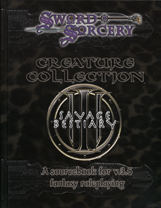 developers: Joseph D. Carriker, Jr. and Anthony Pryor
developers: Joseph D. Carriker, Jr. and Anthony Pryor
interior artist: Jeremy McHugh et al.
cover design: Mike Chaney
publisher: Sword & Sorcery Studios/White Wolf Publishing
publication date: 2003
cover: hardcover
number of pages: 224
ISBN: 978-1588-461384
description: This book contains entries for over 150 creatures. It is compatible with the v3.5 d20 system.
Our featured entry from this bestiary is the beehive golem.
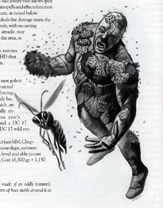 The figure appears to be made of an oddly textured, golden waxy material. A swarm of bees swirls around it as it moves.
The figure appears to be made of an oddly textured, golden waxy material. A swarm of bees swirls around it as it moves.
Swarm: Beehive golems are constantly surrounded by a fiendish bee swarm that attacks the golem's enemies. The golem can expel another such swarm as a standard action every 1d4+1 rounds, up to a maximum number of times per day equal to half the golem's base attack bonus.
Absorb Weapon: Any piercing weapon that successfully strikes a beehive golem is liable to get stuck in its waxy body. The wielder must make a DC 16 reflex save to avoid having the weapon remain stuck in the golem.
Construction of a beehive golem involves summoning enchanted swarms of bees and forcing them to build a large, roughly humanoid-shaped hive in which an elemental spirit is eventually trapped. This requires one year's monitoring of the bees and a DC 17 Profession (beekeeper) or a DC 17 wild empathy check.
|
|
|
|
|
December 24, 2016
Bestiary MS Bodley 764
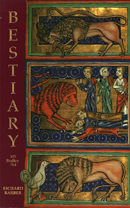 author: unknown
author: unknown
translator: Richard Barber
interior artist: unknown
cover design: unknown
publisher: Boydell & Brewer
publication date: ca. 1220-1250
publication date of English translation: 1992
cover: softcover
number of pages: 206
ISBN: 978-0851-157535
description: This book was written in England circa 1220-1250. It contains 133 entries, most of which are illustrated. It contains an introduction by the translator.
Our featured entry from this bestiary is the harz bird.
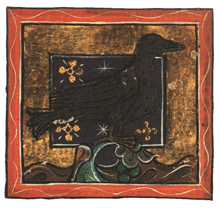 Harz birds come from the Harz Mountains in Germany, which give them their name. Their feathers shine in the darkness, so that, however dark the night, they shine brightly if they are thrown to the ground, and serve to light they way. With the help of their shining feathers, the way is plain.
Harz birds come from the Harz Mountains in Germany, which give them their name. Their feathers shine in the darkness, so that, however dark the night, they shine brightly if they are thrown to the ground, and serve to light they way. With the help of their shining feathers, the way is plain.
|
|
|
|
|
Continue to late addition (2017) entries.
|
|
|
|
|
|
|
|

